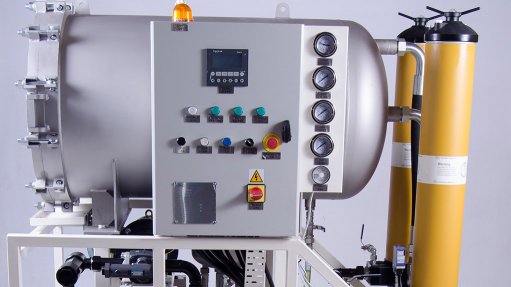
RAPID FREE-WATER CONTAMINATION REMOVAL The Pall HCP200 turbine oil coalescer is designed to remove free-water contamination from oil much faster than centrifuge and vacuum dehydration
Oil-quality maintenance and monitoring services provider to the South African energy market Filtration Management Solutions (FMS) claims to be the only company in Africa using the Pall HCP200 turbine oil coalescer.
Developed by global experts in filtration, separation and purification solutions, the Pall HCP200 is used to filter and remove water in turbine oil.
The Johannesburg company imported the coalescer, which is designed to be a quicker alternative to the removal of free- water contamination, compared with more traditional filtration systems.
The Pall HCP200, which FMS says is the first of its kind in South Africa, is a response to the time, consuming elements of centrifuge and vacuum dehydration that are applied for the removal of high levels of free-water contamination, as they are not efficient over shorter periods, FMS GM Steven Whitcher tells Engineering News.
The coalescer also removes solid particles and emulsions from the oil and can achieve an ISO 4406 cleanliness code of up to 12/09/07.
“Previously, FMS offered Pall vacuum dehydration purifiers for water removal. Although this technology can remove free water, it did so at a much slower rate. The HCP200 enables us to remove water from oil in a greatly reduced timeframe while saving the end-user time and money,” Whitcher adds.
To maintain the water content level in oil, he recommends using the Pall vacuum dehydration purifier after the HCP200 has removed the free water in the system.
The HCP200 can further be used independently as a solid particle filtration unit, as the product can bypass the coalescer function when water removal is not required.
The unit uses high-performance Pall Coralon particle-contamination filters, which incorporate advanced technology. This includes a patented helical wrap pleat support system and composite element structure for added strength, improved efficiency and a longer service life.
Whitcher notes that the filters can be used in a normal particle filtration process with the HCP200 being the only coalescer that is currently using the filter.
When oil enters the coalescer unit after passing through the Coralon particle filter, its point of contact is the coalescer elements. Free and emulsified water become larger droplets of water after passing through filter elements, owing to peculiar polarity molecules in the coalescer, Whitcher explains.
Before the oil enters the separator element, gravity causes the large droplets of water in the oil to fall into the water bag below; however, as a result of inertia, some water droplets pass through to the separator element along with the oil.
The separator element comprises special hydrophobic materials that keep the water droplets out when oil passes through it.
Thereafter, the oil enters the separator element and is discharged from the machine outlet through an outlet pipe. This takes place once the water bag reaches 221 mm of water.